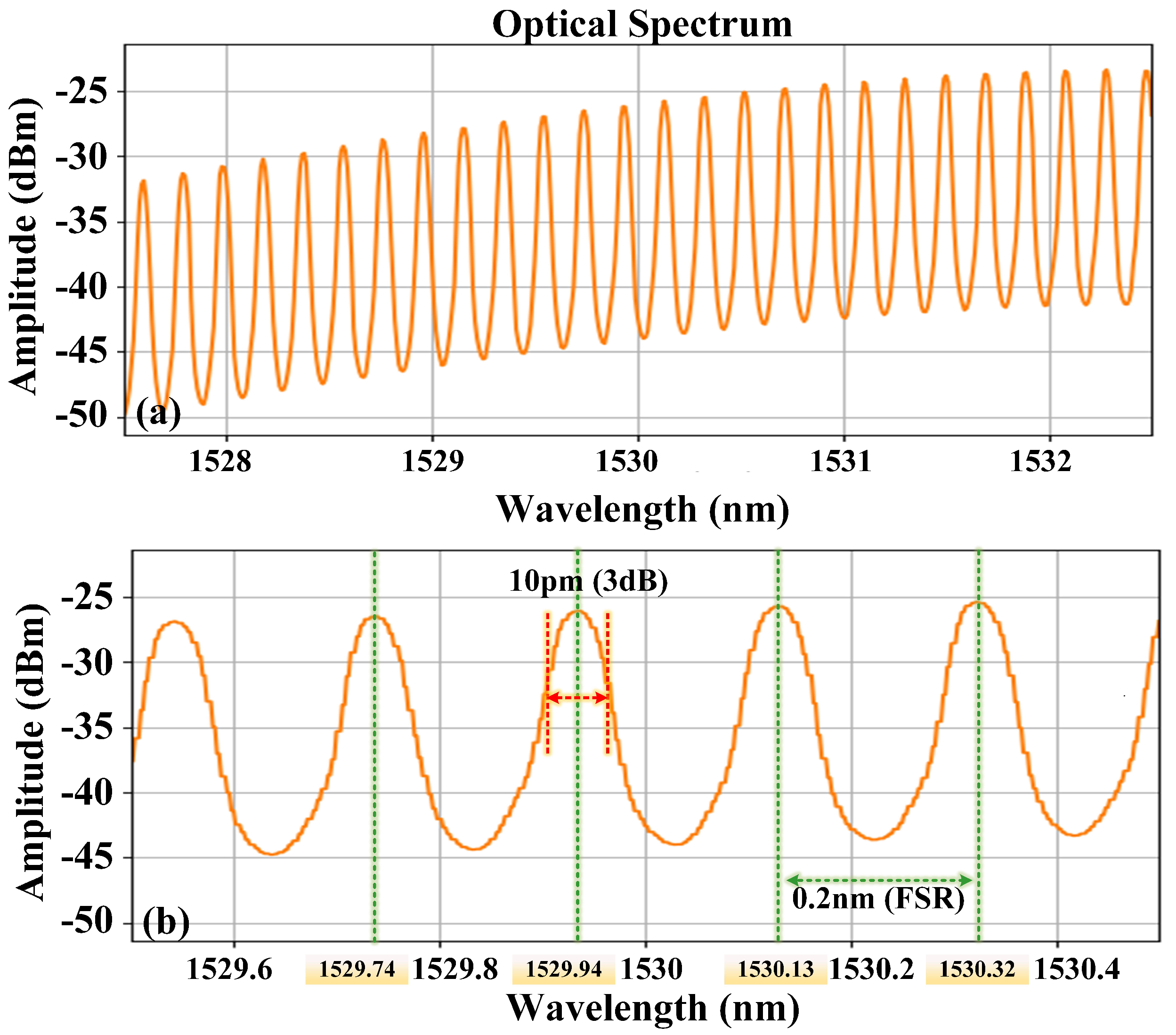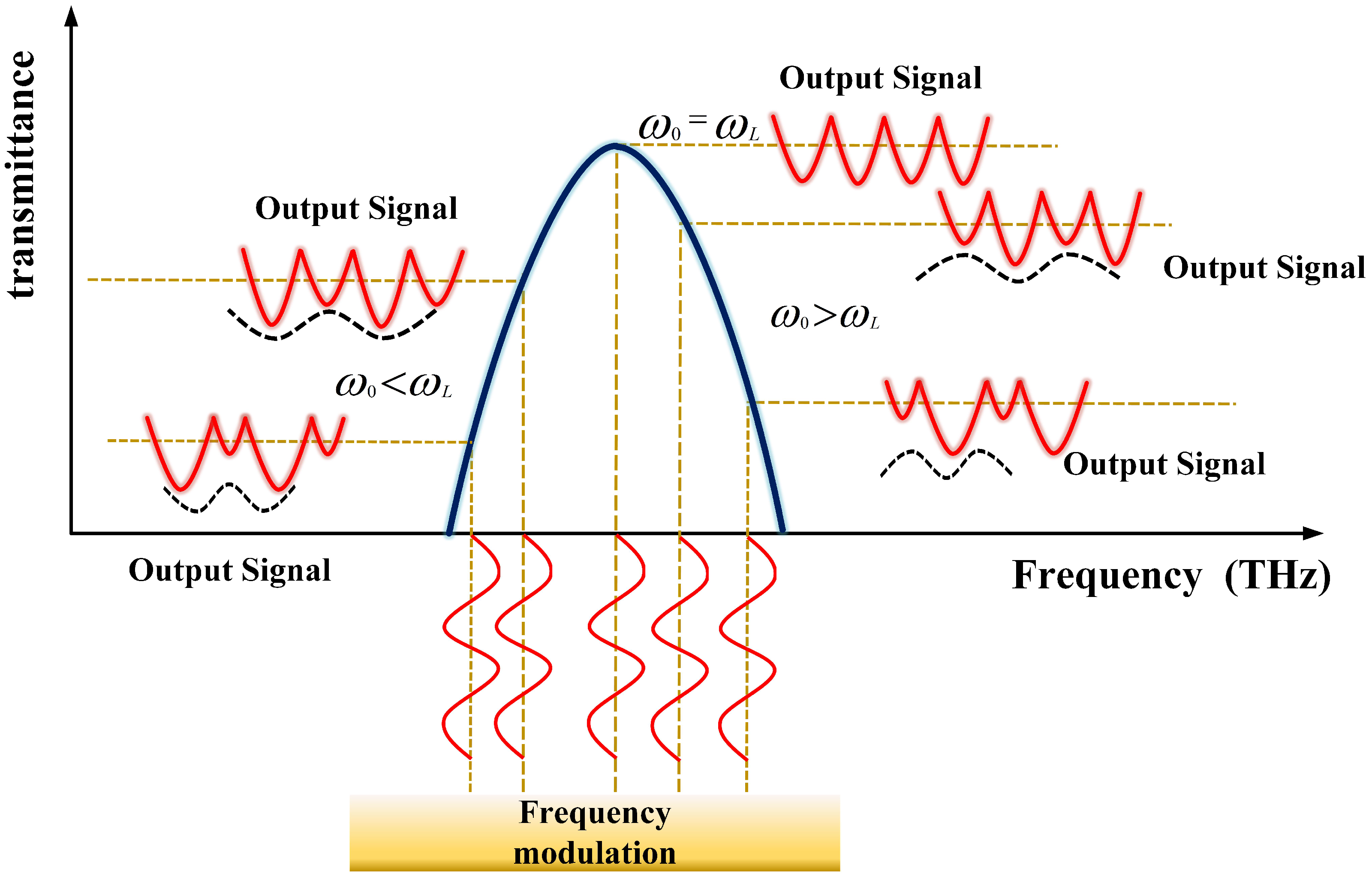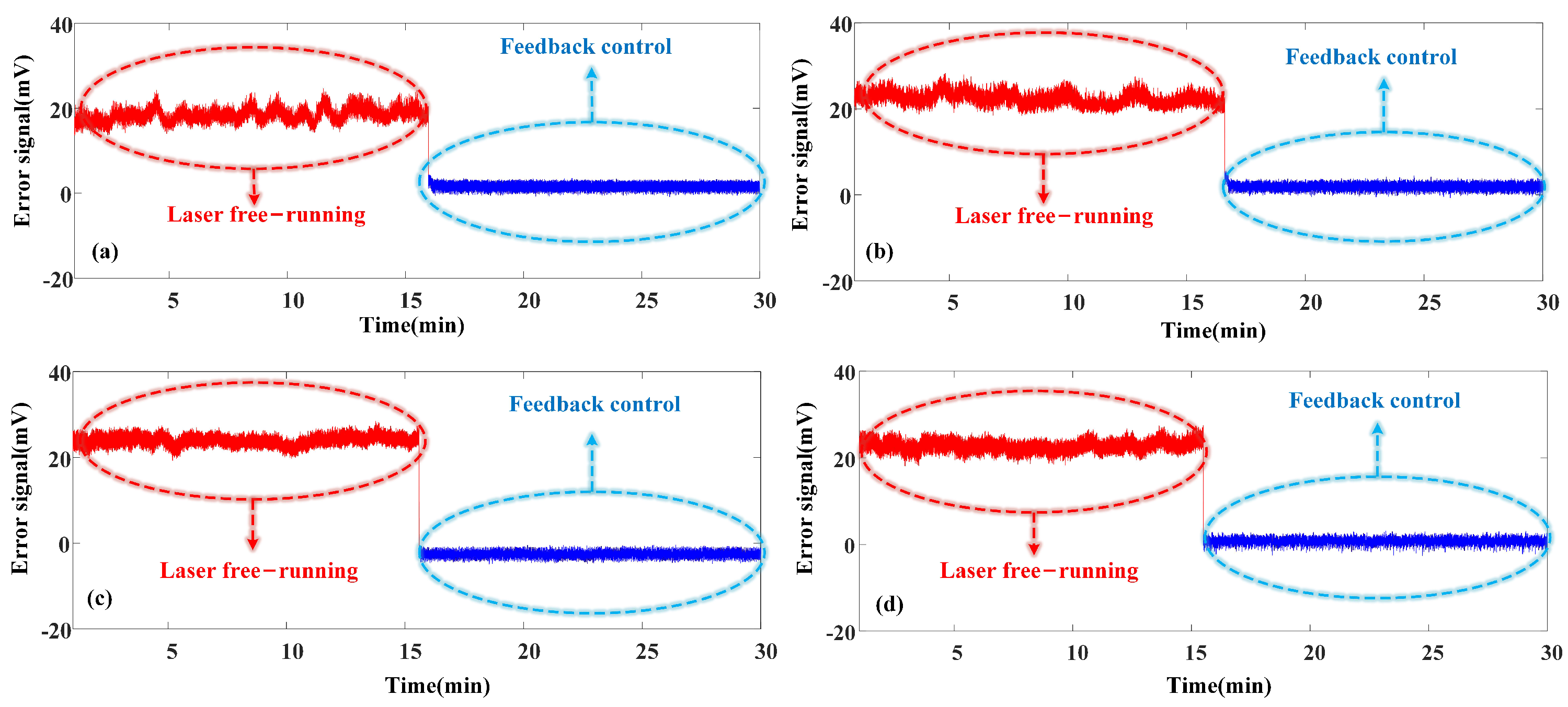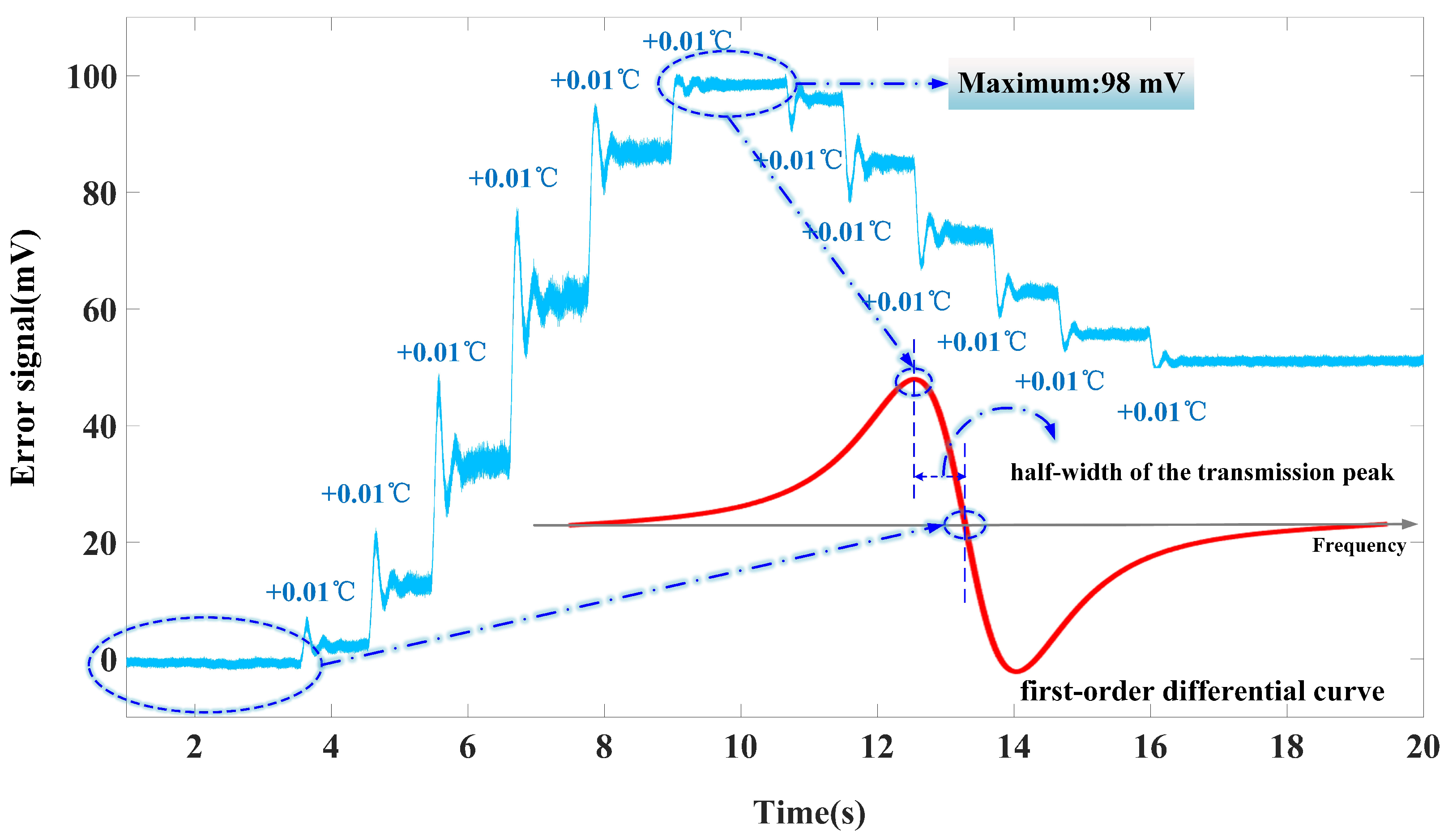Multi-Wavelength Narrow-Spacing Laser Frequency Stabilization Technology Based on Fabry-Perot Etalon
Abstract
:1. Introduction
2. Experimental Principle
2.1. Frequency Identification Properties of the Fabry-Perot Etalon
2.2. Generation of Error Signals
3. Experimental Setup
4. Experimental Results
4.1. Automatic Frequency Stabilization After Power on
4.2. Frequency Stability Estimation
5. Conclusions
Author Contributions
Funding
Data Availability Statement
Conflicts of Interest
References
- Wang, Q.; Tan, L.; Ma, J. Beacon correction method for inter-satellite laser communication. Opt. Commun. 2021, 493, 127035. [Google Scholar] [CrossRef]
- Segarra, J.; Sales, V.; Polo, V.; Tabares, J.; Prat, J. Flexible coherent udwdm-pon with dynamic user allocation based on limited-tunability lasers. J. Opt. Commun. Netw. 2020, 12, D27–D35. [Google Scholar] [CrossRef]
- Wang, J.; Jia, T.; Wang, S.; Li, T.; Ma, C.; Xie, T.; Yu, Y.; Yu, J. Wavelength synchronization technology for udwdm-pon transmitter based on injection locking. Chin. Opt. Lett. 2021, 19, 010602. [Google Scholar] [CrossRef]
- Chen, C.; Qin, Q.-M.; Chen, L.; Wang, J.-L.; Liu, M.-C.; Wen, Q. Extraction of bridge over water from high-resolution remote sensing images based on spectral characteristics of ground objects. Spectrosc. Spectr. Anal. 2013, 33, 718–722. [Google Scholar]
- Xu, B.; Wan, Y.; Fan, X.; He, Z. Whispering-gallery-mode barcode-based broadband sub-femtometer-resolution spectroscopy with an electro-optic frequency comb. Adv. Photonics 2024, 6, 016006. [Google Scholar] [CrossRef]
- Smith, D.T.; Pratt, J.R.; Howard, L. A fiber-optic interferometer with subpicometer resolution for dc and low-frequency displacement measurement. Rev. Sci. Instrum. 2009, 80, 3. [Google Scholar] [CrossRef]
- Thurner, K.; Braun, P.-F.; Karrai, K. Absolute distance sensing by two laser optical interferometry. Rev. Sci. Instrum. 2013, 84, 11. [Google Scholar] [CrossRef]
- Tan, D.; Grieco, A.; Fainman, Y. Towards 100 channel dense wavelength division multiplexing with 100ghz spacing on silicon. Opt. Express 2014, 22, 10408–10415. [Google Scholar] [CrossRef]
- Balaji, V.R.; Murugan, M.; Robinson, S. Optimization of dense wavelength division multiplexing demultiplexer with 25ghz uniform channel spacing. arXiv 2016, arXiv:1608.00235. [Google Scholar]
- Wu, Y.; Sun, B.; Li, X. Semiconductor laser active frequency stabilization technologies: A review. J. Korean Phys. Soc. 2021, 79, 795–809. [Google Scholar] [CrossRef]
- Torres-Company, V.; Schröder, J.; Fülöp, A.; Mazur, M.; Lundberg, L.; Helgason, O.B.; Karlsson, M.; Andrekson, P.A. Laser frequency combs for coherent optical communications. J. Lightwave Technol. 2019, 37, 1663–1670. [Google Scholar] [CrossRef]
- Zhou, P.; Sun, W.; Liang, S.; Chen, S.; Zhou, Z.; Huang, Y.; Guan, H.; Gao, K. Digital long-term laser frequency stabilization with an optical frequency comb. Appl. Opt. 2021, 60, 6097–6102. [Google Scholar] [CrossRef] [PubMed]
- Li, J.; Liu, J.; de Melo, L.; Luo, L.; Lai, T.; Wang, Z. Sub-megahertz frequency stabilization of a diode laser by digital laser current modulation. Appl. Opt. 2015, 54, 3913–3917. [Google Scholar] [CrossRef]
- Wang, K.; Tian, H.; Meng, F.; Lin, B.; Cao, S.; Pi, Y.; Han, Y.; Fang, Z.; Song, Y.; Hu, M. Fiber-delay-line-referenced optical frequency combs: Three stabilization schemes. Chin. Opt. Lett. 2022, 20, 021204. [Google Scholar] [CrossRef]
- McFerran, J. Laser stabilization with a frequency-to-voltage chip for narrow-line laser cooling. Opt. Lett. 2018, 43, 1475–1478. [Google Scholar] [CrossRef]
- Couturier, L.; Nosske, I.; Hu, F.; Tan, C.; Qiao, C.; Jiang, Y.; Chen, P.; Weidemüller, M. Laser frequency stabilization using a commercial wavelength meter. Rev. Sci. Instrum. 2018, 89, 4. [Google Scholar] [CrossRef]
- Zektzer, R.; Hummon, M.T.; Stern, L.; Sebbag, Y.; Barash, Y.; Mazurski, N.; Kitching, J.; Levy, U. A chip-scale optical frequency reference for the telecommunication band based on acetylene. Laser Photonics Rev. 2020, 14, 1900414. [Google Scholar] [CrossRef]
- Wang, J.; Gao, Y.; Yu, J.; Cai, Z.; Luo, H.; Ma, C. Simplified 1.5 μm distributed feedback semiconductor laser (dfb-ld) frequency stabilization system based on gas absorption chamber. Photonics 2024, 11, 621. [Google Scholar] [CrossRef]
- Sharma, L.; Roy, A.; Panja, S.; De, S. Stabilizing frequency of a diode laser to a reference transition of molecular iodine through modulation transfer spectroscopy. Atoms 2023, 11, 83. [Google Scholar] [CrossRef]
- Ding, J.; Yu, G.; You, D.; Qian, Y.; Fang, C.; Li, B.; Zhou, J.; Zhu, X.; Wei, W. Compact and high reliable frequency-stabilized laser system at 589 nm based on the distributed-feedback laser diodes. Appl. Phys. B 2021, 127, 130. [Google Scholar] [CrossRef]
- Adamiec, P.; Kinder, T.; Quatrevalet, M.; Ehret, G.; Barbero, J. Dfb laser frequency stabilization unit at 1572 nm. In Proceedings of the International Conference on Space Optics—ICSO 2022, Dubrovnik, Croatia, 3–7 October 2022; Volume 12777, pp. 2563–2569. [Google Scholar]
- Wu, Y.; Qin, F.; Li, Y.; Ding, Z.; Xu, R. Designing an automatic frequency stabilization system for an external cavity diode laser using a data acquisition card in the labview platform. Appl. Sci. 2023, 14, 308. [Google Scholar] [CrossRef]
- Chu, Y.; Liu, D.; Wu, D.; Wang, Z.; Deng, Q.; Kuang, Z.; Lu, L.; Peng, Z.; Fang, Z.; Xie, C.; et al. A method of measuring fp transmittance based on whispering gallery mode light source. In Proceedings of the Eleventh International Conference on Information Optics and Photonics (CIOP 2019), Xi’an, China, 6–9 August 2019; Volume 11209, pp. 503–510. [Google Scholar]
- Yao, Y.; Zou, C.; Yu, H.; Guo, J.; Li, Y.; Liu, J. The developing condition analysis of semiconductor laser frequency stabilization technology. J. Semicond. 2018, 39, 114004. [Google Scholar] [CrossRef]
- Zhang, X.; Xie, F.; Chen, M.; Yang, Y. A highly stable frequency single-mode optical fiber laser based on a fabry-perot etalon. Opt. Fiber Technol. 2022, 73, 103047. [Google Scholar] [CrossRef]
- Chu, Y.; Liu, D.; Wu, D.; Wang, Z.; Deng, Q.; Kuang, Z.; Li, L.; Zhuang, P.; Fang, Z.; Xie, C.; et al. A method of measuring Fabry-Parot etalon transmittance by using frequency comb laser. EPJ Web Conf. 2020, 237, 07001. [Google Scholar] [CrossRef]
- Hao, J.; Tang, L.; Ye, H.; Hao, Z.; Han, J.; Zhai, Y.; Zhang, K.; Wei, R.; Xiao, D. Effect of near-field distribution on transmission characteristics of fiber-fed Fabry–Perot etalons. Astron. J. 2021, 161, 258. [Google Scholar] [CrossRef]
- Park, J.; Seok, J.; Hong, J. Autoencoder-based signal modulation and demodulation methods for sonobuoy signal transmission and reception. Sensors 2022, 22, 6510. [Google Scholar] [CrossRef]
- Wang, Q.; Lai, S.; Qi, X.; Wang, Z.; Chen, X. Design of laser frequency stabilization experiment system based on saturated absorption spectroscopy. Exp. Technol. Manag. 2021, 38, 23–28. [Google Scholar]
- Zhou, J.; Zhao, H.-F.; Yu, T.; Xue, L.; Ma, X.-H. Frequency stabilization of 1.53 μm FBG ECLD based on C2H2 absorption lines. Chin. J. Quantum Electron. 2005, 22, 603–606. [Google Scholar]








Disclaimer/Publisher’s Note: The statements, opinions and data contained in all publications are solely those of the individual author(s) and contributor(s) and not of MDPI and/or the editor(s). MDPI and/or the editor(s) disclaim responsibility for any injury to people or property resulting from any ideas, methods, instructions or products referred to in the content. |
© 2024 by the authors. Licensee MDPI, Basel, Switzerland. This article is an open access article distributed under the terms and conditions of the Creative Commons Attribution (CC BY) license (https://creativecommons.org/licenses/by/4.0/).
Share and Cite
Wang, J.; Gao, Y.; Yu, J.; Luo, H.; Su, X.; Zhang, S.; Zhang, R.; Ma, C. Multi-Wavelength Narrow-Spacing Laser Frequency Stabilization Technology Based on Fabry-Perot Etalon. Micromachines 2024, 15, 1269. https://doi.org/10.3390/mi15101269
Wang J, Gao Y, Yu J, Luo H, Su X, Zhang S, Zhang R, Ma C. Multi-Wavelength Narrow-Spacing Laser Frequency Stabilization Technology Based on Fabry-Perot Etalon. Micromachines. 2024; 15(10):1269. https://doi.org/10.3390/mi15101269
Chicago/Turabian StyleWang, Ju, Ye Gao, Jinlong Yu, Hao Luo, Xuemin Su, Shiyu Zhang, Ruize Zhang, and Chuang Ma. 2024. "Multi-Wavelength Narrow-Spacing Laser Frequency Stabilization Technology Based on Fabry-Perot Etalon" Micromachines 15, no. 10: 1269. https://doi.org/10.3390/mi15101269
APA StyleWang, J., Gao, Y., Yu, J., Luo, H., Su, X., Zhang, S., Zhang, R., & Ma, C. (2024). Multi-Wavelength Narrow-Spacing Laser Frequency Stabilization Technology Based on Fabry-Perot Etalon. Micromachines, 15(10), 1269. https://doi.org/10.3390/mi15101269





